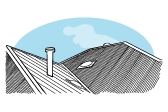
Roof penetrations, as the name suggests, are holes in the surface of the roof. Penetrations need to be carefully planned to ensure that they’re properly weather sealed.

Types of penetrations
Ideally, a building’s roof will be completely sealed, in order to protect residents, interior finishes, and furnishings against moisture, wind and dust. This seal constitutes part of your home’s building envelope. Far from being a featureless, unblemished surface though, most roofs are punctured with holes – or penetrations, as they’re called. Chimneys, pipes, skylights, exhaust fans, vents and air conditioning units all fall into the category of roof penetrations.
Why penetrate a roof?
There are many good reasons for penetrating a roof. For example, chimneys transport smoke out of the building. Without a chimney, your house would become choked with smoke – unpleasant and dangerous.
Exhaust vents are used to remove steam, smells and smoke from the kitchen. In the bathroom, a vent sucks out moist air and odours. While the removal of odours is more of a convenience than anything, a damp bathroom can actually cause damage to your home by encouraging the growth of mould and/or allowing rot to set in.
Skylights, another form of penetration, improve natural light, and are very important thanks to new laws regulating how much daylight needs to be allowed into rooms in new homes.
Results of penetrations
Penetrating your roof is something of a necessary evil. It is associated with two main problems. First, roof penetrations puncture your building envelope, potentially letting in wind, rain or vermin if they’re not properly sealed off. A well managed penetration should be completely sealed off so that none of these things is allowed into your home.
How are penetrations made?
While there are always going to be retrofit penetrations, where possible, penetrations should be installed before your roof cladding goes on. This will save the effort of removing and then replacing the cladding. Whether you are penetrating your roof during construction or after, you also need to make sure that your flashing and seals aren’t going to have a negative, corrosive reaction with your roof cladding material.





